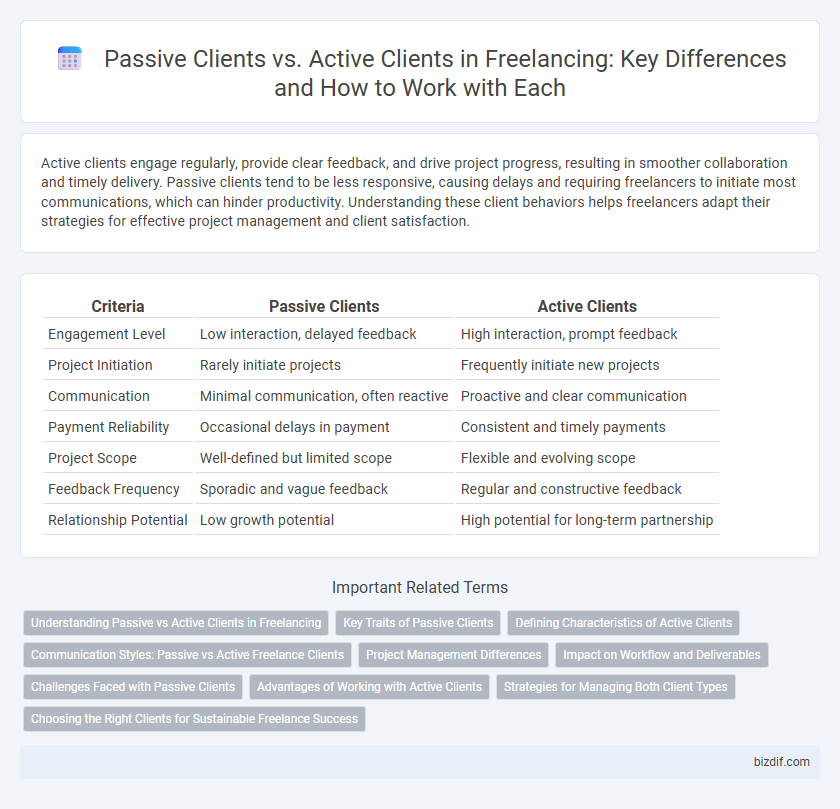Active clients engage regularly, provide clear feedback, and drive project progress, resulting in smoother collaboration and timely delivery. Passive clients tend to be less responsive, causing delays and requiring freelancers to initiate most communications, which can hinder productivity. Understanding these client behaviors helps freelancers adapt their strategies for effective project management and client satisfaction.
Table of Comparison
| Criteria | Passive Clients | Active Clients |
|---|---|---|
| Engagement Level | Low interaction, delayed feedback | High interaction, prompt feedback |
| Project Initiation | Rarely initiate projects | Frequently initiate new projects |
| Communication | Minimal communication, often reactive | Proactive and clear communication |
| Payment Reliability | Occasional delays in payment | Consistent and timely payments |
| Project Scope | Well-defined but limited scope | Flexible and evolving scope |
| Feedback Frequency | Sporadic and vague feedback | Regular and constructive feedback |
| Relationship Potential | Low growth potential | High potential for long-term partnership |
Understanding Passive vs Active Clients in Freelancing
Passive clients in freelancing typically require minimal interaction, offering projects with clearly defined scopes and timelines, which allows freelancers to work independently and efficiently. Active clients engage frequently, providing ongoing feedback, adapting project requirements, and often collaborating closely to ensure the final output aligns with evolving needs. Understanding the distinction between passive and active clients helps freelancers tailor communication strategies and project management approaches, ultimately enhancing client satisfaction and project success.
Key Traits of Passive Clients
Passive clients typically exhibit low communication frequency, delayed feedback, and minimal involvement in project details, resulting in slower decision-making processes. They often provide vague or incomplete project requirements, which can lead to scope creep and misunderstandings. Understanding these key traits helps freelancers manage expectations and implement strategies for clearer communication and timely deliverables.
Defining Characteristics of Active Clients
Active clients consistently engage by providing clear project briefs, timely feedback, and prompt payments, ensuring smooth workflow and improved project outcomes. They often initiate regular communication, set realistic deadlines, and express specific needs, facilitating efficient collaboration and mutual understanding. Their proactive involvement reduces misunderstandings and accelerates project delivery, making them highly valuable in freelancing relationships.
Communication Styles: Passive vs Active Freelance Clients
Passive freelance clients often provide vague instructions and minimal feedback, making project clarity and progress tracking challenging. Active freelance clients engage consistently through clear, detailed communication, fostering a productive collaboration and timely adjustments. Understanding these communication styles helps freelancers tailor their approach for improved client satisfaction and project outcomes.
Project Management Differences
Active clients require constant communication, regular updates, and collaborative decision-making, demanding a more hands-on project management approach. Passive clients tend to provide minimal input and feedback, which necessitates proactive progress tracking and clearer milestone definitions to keep the project on schedule. Effective project management adjusts strategies based on client engagement levels to ensure timely delivery and client satisfaction.
Impact on Workflow and Deliverables
Active clients provide timely feedback and clear instructions, which streamline the workflow and enhance the quality of deliverables. Passive clients often cause delays by responding late or offering vague input, disrupting project timelines and reducing overall efficiency. Consistent communication from active clients ensures smooth collaboration and higher client satisfaction in freelancing projects.
Challenges Faced with Passive Clients
Passive clients often present significant challenges in freelancing due to their lack of timely feedback and unclear communication, which can delay project progress and result in misunderstandings. These clients may be unresponsive during crucial stages, making it difficult to align deliverables with their expectations and increasing the likelihood of revisions. Managing passive clients requires freelancers to implement proactive communication strategies and set explicit milestones to ensure project continuity and clarity.
Advantages of Working with Active Clients
Active clients provide consistent project flow and timely feedback, which enhances productivity and allows freelancers to refine their work continuously. These clients often have clear goals and are proactive in communication, reducing misunderstandings and project delays. Working with active clients builds stronger professional relationships and increases opportunities for repeat business and referrals.
Strategies for Managing Both Client Types
Active clients demand regular communication and detailed project updates, making consistent responsiveness and clear milestone tracking essential for maintaining trust and satisfaction. Passive clients require proactive engagement through periodic check-ins and value demonstrations to prevent disengagement and foster ongoing collaboration. Tailoring communication frequency and project management tools to each client type optimizes workflow efficiency and strengthens long-term client relationships in freelancing.
Choosing the Right Clients for Sustainable Freelance Success
Active clients engage regularly, provide timely feedback, and contribute to steady revenue, enabling freelancers to maintain consistent workflow and growth. Passive clients often delay communication and projects, creating unpredictability and potential cash flow issues, which can hinder long-term freelance success. Prioritizing active clients enhances project efficiency, client satisfaction, and sustainable income streams in freelancing.
Passive clients vs Active clients Infographic

 bizdif.com
bizdif.com